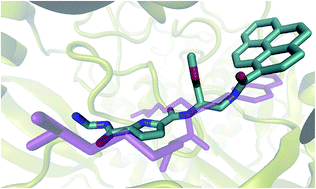Guanidiniocarbonyl-pyrrole-aryl conjugates as inhibitors of human dipeptidyl peptidase III: combined experimental and computational study†
Abstract
Dipeptidyl peptidase III (DPP III) is a zinc dependant peptidase which catalyses hydrolysis of the second peptide bond from the N-termini of its substrates. DPP III is an enzyme of broad substrate specificity and it has been found in many organisms. It has been recognised in several processes of interest for drug development like pain modulation and defence against oxidative stress. However, its fundamental physiological role is unknown and specific inhibitors would be of significant help in identifying this role. In this work we combined experimental (UV/Vis, fluorimetry and microcalorimetry experiments) with molecular dynamic simulations to study the binding of several newly designed and synthesised guanidiniocarbonyl-pyrrole-aryl conjugates to human DPP III. We found that new compounds bind with micromolar affinity to the enzyme and with varied efficiency inhibit hydrolysis of Arg-Arg-2-naphthylamide, the standard synthetic substrate of DPP III. The molecular modelling study revealed multiple binding modes of the guanidiniocarbonyl-pyrrole-aryl conjugates into the active site of human DPP III. In order to elucidate which one is the most favourable we studied the molecular determinants for their binding to DPP III as well as their influence on protein structure. It seems that the main requirement for a good DPP III inhibitor is a bulky aryl-substituent and a linker of suitable length and flexibility between it and the guanidiniocarbonyl-pyrrole. The obtained results gave directions for future development and improvement of DPP III inhibitors.


 Please wait while we load your content...
Please wait while we load your content...